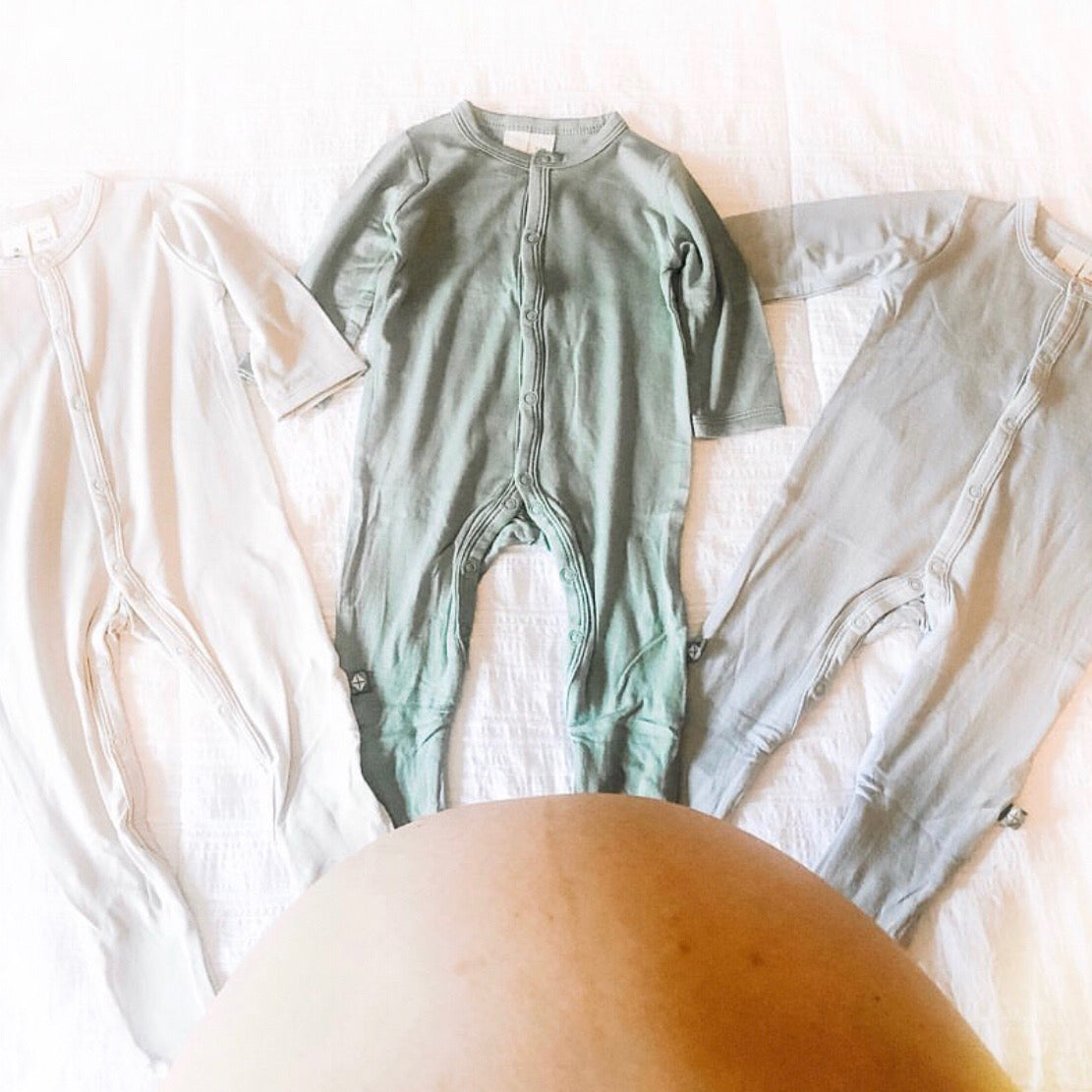After you leave the newborn stage, your next question may be, “when will my baby roll over?” Those gross motor skills can almost seem to come out of nowhere and surprise both you and your baby!
Do not be shocked to find that rolling is one of your baby’s new favorite skills to practice both during their awake time and while they are sleeping. Rolling is a great feat for your little one! It requires a lot of strength and coordination, head control, and using multiple muscles at once to achieve this milestone.
When Do Babies Roll Over?
Some babies will roll onto their side within days of being born. This is natural and referred to as a “newborn curl.” They have spent months curled up in your womb, so it is a position of comfort for your little one.
Most babies will lose that ability within the first month. By 4 months of age, most babies have developed sufficient strength to use their arms in order to propel themselves up and over from their stomach onto their back.
The American Academy of Pediatrics (AAP) says that by 7 months old, most babies have mastered the art of rolling over. At first, this movement may not be intentional as the weight of their head leads them over onto their back. But as they discover cause and effect, they will be on the move in no time!
There is a range, of course, for developing this intentional skill. Some babies will be able to perform the mini arm push up early on (as early as 1 month, 2 months or 3 months) and others may take up to 6 or 7 months to figure out or master rolling.
It is important to note that this skill may happen rather unexpectedly! Therefore, try to not leave your baby unattended on beds, couches, changing tables, etc as they could end up on the floor! Do not be surprised if your little one begins to roll consistently and then does not roll again for a while. It is normal for the skill to “come and go” as it integrates into their repertoire.
How Can I Encourage My Baby to Roll?
According to BabyCenter, “Your baby may be able to kick himself over, from his tummy to his back, as early as age 4 months. It may take him until he's about 5 or 6 months to flip from back to front, though, because he needs stronger neck and arm muscles for that manoeuvre.”
According to Sarah Johnson, a board-certified physical therapist at Riley Children’s Health, “To roll from back to belly, they have to develop enough strength in their flexors, which are the muscles on the front of their bodies, so it's just easier to use their extensors, or back muscles, to roll and then push with their arms,"
Tummy time is good to do throughout the day, potentially 2-3 times a day for 3-5 minutes at a time. As they get more used to it, you can increase the frequency and duration!
Alternatives to tummy time include:
- Skin to skin on your chest (or your partners, older siblings even!)
- Make it a part of your routine (for instance, after a diaper change, let baby hang out for a few moments on their belly to adjust)
- Incorporate it after bath time while doing a little infant massage with lotion
- Prop baby up using a boppy pillow or receiving blanket (you can also prop them with your hands which keeps baby close to you and may make them hate tummy time a little less!)
- A baby may prefer to do tummy time across your lap/knees
- The “football hold” is great for dads to do
- A baby may like tummy time on an exercise ball (keep a good hold on the baby and the ball!)
- Make it fun (sing songs, play peekaboo, use rattles, mirrors, black and white/contrasting engaging books)
- Lay on your back and lift your shins perpendicular to the floor. Place baby on her tummy on your shins and gently sway or lift your legs while holding her arms or side.
- Babywearing
Try not to do tummy time when a baby is already tired or becoming overtired. We want a positive association with this exercise! Fresh from a nap, or in the morning may work best for your little one. Do not get discouraged. Every minute of tummy time will add up during the day until it is your baby’s new favorite position to play in.
When Do Babies Crawl?
If your little one has mastered rolling, you might be thinking ahead to when they will be even more mobile! "Crawling is a huge milestone for babies because it's the first step toward independent mobility," says Rallie McAllister, M.D., co-author of The Mommy MD Guide to Your Baby's First Year.
According to most sources, babies will begin crawling on all fours between 6-10 months. While learning this skill, it is important to give your baby a lot of independent floor time/tummy time.
A common question I find is if it’s okay if babies skip crawling, and the answer is no! They do need to crawl as it is very important for brain development. There are various crawling “modes” and each kid may do it a little differently until they master a traditional crawl. That may look something like:
- classic crawl (moving one arm and the opposite leg together at the same time to push forward)
- scoot (dragging the bottom across the floor)
- crab crawl (moving with one knee bent and the other extended, either forward or sideways)
- army crawl (lying flat on the tummy and using the arms to move forward)
- backward crawl
Can Babies Roll Over at 2 Months?
Most babies will follow their own timeline in development! Yes, your baby can roll over intentionally at any point; they may fall early or late on the timeline. This means babies rollover at 1 month is possible. Similarly, baby rolling over at 3 months is also observed.
As long as your baby is making progress like being able to push up on his arms, clear his head from side to side, or is starting to get in other positions while on his back, then they’re on track! If you’re ever concerned about development, you can look into a free consultation from early childhood development.
Fun fact: Newborns have what’s called a fencing reflex, which is meant to prevent them from rolling over in those first few weeks. When a newborn’s face is turned to one side, baby’s arm and a leg on that side extend while the opposite arm and leg flex.
“It’s nature’s built-in mechanism for preventing SIDS,” says pediatrician Cheryl Wu, MD. As the reflex starts to disappear (it should be completely gone by 6 months old), and you notice baby has the strength and muscle tone to hold his or her head up more, you can take those as signs that you’ll soon see baby rolling over.
Do All Babies Roll?
Yes, all babies should roll. Getting onto their belly is a very important developmental skill that will lead to other milestones.
Here is how it may start:
-
Around 2-3 months, baby begins to turn from his back to his side. From this position, he can reach for toys but is still unstable and has to focus on staying balanced. When this position becomes easier, the baby might relax a bit more and accidentally roll onto his tummy or his back. If it’s his tummy he lands on, he may not be too happy!
- 4-7 months, baby may continue strengthening his back and neck in the push-up position and may spend more time there playing. He practices stretching and reaching which tones his trunk (body) in preparation for rolling over, crawling, and sitting.
How Can I Help Baby Roll Over?
Around 3 months of age, your baby will begin to do a “mini pushup”, lifting their chest slightly off the ground and picking their head up more. This helps your little one strengthen those muscles in order to prepare for rolling.
Around 5 months of age, your baby will be able to fully extend their arms and arch their back to lift their chest off the ground. At that point, the weight of their head may help them roll over onto their back!
The most common way to encourage your baby to roll over is through play. Try holding that toy just far enough away so reaching does not suffice, or alternatively try laying down aside your little one and attempt to demonstrate a roll and see what the reaction is. Be sure to applaud and make a fuss of a roll, as this can positively reinforce the daring movement for the baby.
Pro tip: If your baby does not seem to like tummy time, it might be because it is uncomfortable for them. Since their head is so much heavier, it can weigh them down. While they are on their belly, gently apply pressure down on their bottom, pushing toward their feet to “unweight” their head. They may enjoy it a lot more then!
Some exercises to encourage rolling both ways include:
- Lay your baby down on their back and roll their body gently side to side (this is something you can do from birth)
- Allow lots of playtime on baby’s side. Prop baby on their side and place a toy in front of them to hold their attention and engage them. Be sure to spend equal time on their left side, right side, back, and tummy!
-
Encourage baby to play in/cross midline.
- Carry baby in a variety of positions (facing out, on their side, etc)
- Encourage tracking and head-turning by holding a toy off to the side and engaging with your baby
- Lay beside your baby and encourage them to turn toward you
Tummy time is so important for our little ones! It can be helpful in preventing plagiocephaly also known as flathead. Some other things you can do to prevent that are to change your baby’s head position by alternating positions in the crib, especially if the crib is against a wall:
- Place your baby with their head at the head of the crib.
- The next day, place your baby with their head at the foot of the crib. They’ll likely turn their head the other way to maintain the view into the room.
- Continue alternating in this way.
- Remove any overhead hanging mobile toys so your baby looks to the side and not straight up.
- Check to make sure your baby is lying or sleeping on their back but has their face turned towards the room
Torticollis is another risk until your baby is able to move into more positions; however, this is also common from positioning in the womb! According to Healthline, “Torticollis in babies can be hard to miss because they don’t yet move their necks very much. But if your sweet little one has this neck condition, you may notice signs like:
- tilting the head in one direction
- preferring to breastfeed on one side only
- moving their eyes to look over their shoulder at you rather than turning their head to follow you
- being unable to turn the head completely
Torticollis can also affect how your baby sleeps. Your baby may prefer sleeping on one side or turning their head to the same side every night to be more comfortable. But this isn’t ideal. Continue to place your baby on their back.”
What Do I Do If My Baby Starts Rolling Too Early?
If your baby is able to roll over, either back to belly or belly to back, then you will need to discontinue swaddling. Swaddling is defined as being wrapped up with their arms restricted; if their arms are free, they are not swaddled. It is important to know when to stop swaddling your baby.
If your baby remains swaddled and accidentally rolls, they could compromise their airway because their arms are not free to get out of that position. Read up on how to help babies sleep safely. Remember to maintain a safe sleep environment, but here are some highlights:
- Use a firm sleep surface
- Use a sleep sack instead of a loose blanket
- No other objects in the crib except baby including bumpers
Experts agree that once your baby can get themselves into different positions, it is safe to leave them in that position. You should continue to place them on their back to sleep and allow them to assume a position they are comfortable in!
Some parents may want to place their baby in other positions, like their side or tummy because they believe it will be safer, especially if they have reflux and they’re worried they may choke.
Rest assured, “the NIH says that studies show back sleeping has a lower risk of choking. Babies are better able to clear their airways while sleeping on their backs. They have automatic reflexes that make them cough up or swallow any spit-up that happens, even while sleeping.”
It is not uncommon to experience a sleep regression when your baby begins rolling. The reason this disrupts sleep so much is because babies do not have the same muscle paralysis that adults do when they sleep. When a baby is working on a new skill, it is being integrated in their brain during deep sleep.
That means when they are “dreaming” about their skill, they may very well practice it- in their sleep! So they end up rolling, then waking themselves up, and they are disoriented because of the positional change.
This can be a frustrating phase for parents! Because if we continue to just roll them back, it essentially delays them from figuring out that it is okay to sleep in other positions, or that they can in fact get comfortable and return to sleep while they are on their belly.
I encourage the families that I work with to not roll baby back onto their back too often and to soothe them while they are laying on their stomach. This way they are able to connect the position with sleep. This will help them learn to master the skill of rolling over both ways as quickly as possible and minimize the sleep disruption!
You may find your challenging sleeper sleeps best on their belly! This is totally fine once they can move into that position themselves. Catch up on those “zzz’s”, mama!
Baby Still Not Rolling Over at 6 Months?
If your baby is not rolling over at 6 months, your pediatrician may inquire at their well check. Some babies do develop later than others, but if you suspect they are a little behind in their milestones, it does not hurt to start doing more exercises/spending more time on their tummy to encourage rolling!
Most states will have resources like early childhood intervention that will do a free evaluation to see if your little one qualifies for their services. If you are curious, you can always google “ECI + your state” to find local resources! Your pediatrician will also be able to offer you a referral
How Does a Baby Roll Over?
In order for a baby to roll over from belly to back, they need to develop the strength in their arms to push up from the floor to clear their shoulder. Once they can clear their shoulder, they can usually roll themselves onto their back!
In order for a baby to roll over from back to belly, they will need to be able to cross the midline, get onto their side, and develop enough core strength to continue onto their belly.
When Do Babies Roll From Back to the Side?
A baby may roll onto their side from birth! This is a precursor for rolling from back to belly or belly to back. Once they can get their legs over and start to cross the midline, their body may naturally roll into that side position. Once this starts to happen, you will need to transition out of the swaddle and let their arms stay free.
Whether your baby rolls over at 3 months, 5 months, or 8 months, needless to say, there are a lot of fun milestones that will come after that! Once your baby has mastered rolling, they will begin to sit independently and then they will master crawling, standing, cruising, and walking. Baby proof those houses, parents! Your baby will be on the move before you know it. Then you will be wondering when they sit still again. (Spoiler, maybe when they are teens!)
AUTHOR:
Ashley Olson is a certified pediatric sleep consultant, owner of Heaven Sent Sleep, and passionate about helping new parents experienced parents, desperate and sleep-deprived parents form healthy sleep habits for their children.
She has over 3 years of experience in working with families and has completed over 150 hours of coursework plus continuing education related to infant and toddler sleep. The focus of her work is on fostering a routine that grows your bond with your child while improving their sleep habits. She specializes in custom sleep plans and one on one support in changing sleep practices!




















